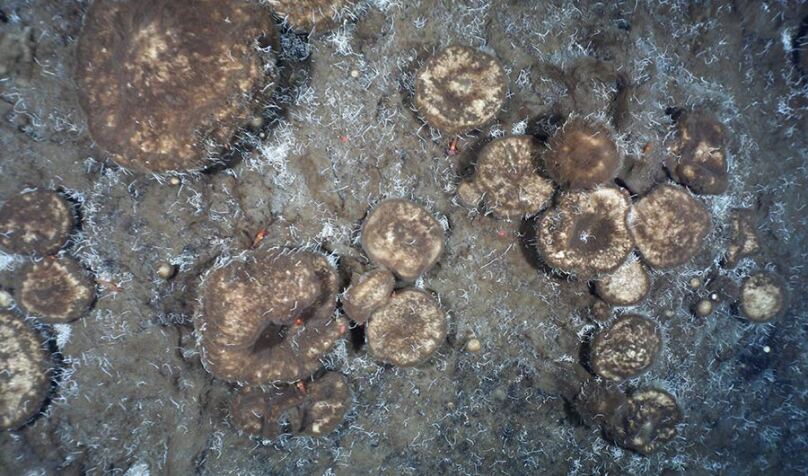The Sponges That Feed on an Extinct Ecosystem

Sponges on the Langseth Ridge seamount
Alfred Wegener Institut/PS 101 AWI OFOS system/ Antje Boetius
(Inside Science) -- Several thousand years ago tube worms thrived near hydrothermal vents on three seamounts in the central Arctic. When the vents became inactive, they died. Most of the softer organic tissue disappeared quickly, leaving nothing but hard tubes on top of these underwater mountains on Langseth Ridge north of the Norwegian Svalbard Archipelago. There they sat for centuries -- a testament to a lost ecosystem. Then, sponges came along and began to clean up some of the last traces of the tube worms’ presence.
“Sponges have never stopped surprising me,” said Teresa Morganti, a marine biologist who worked with the Max Planck Institute for Marine Microbiology in Bremen, Germany, when she began studying the ecology of three sponge species found on the Langseth Ridge.
Her colleague Antje Boetius, a deep-sea ecologist at the same institute, led an expedition in 2016 to the ice-covered region of the central Arctic. Part of their work involved towing a camera and sonar system behind a boat that recorded sound, footage and images. They also collected some sediment samples. At a depth of about 600-800 meters, they found a large sponge community made up mostly of three species: Geodia parva, G. hentscheli and Stelletta rhaphidiophora. Sponges are filter feeders, usually consuming particles that float down in the water column. “Sponges are like very primitive forms of animal life,” Morganti said.
But this region is so poor in nutrients that it was surprising to see so many sponges, as well as some particularly large ones. “We observed individuals of up to 1 meter in diameter,” Morganti said. “This is the first time, as far as I know, that this species has been found in such an ecosystem.”
Boetius and her colleagues connected with Morganti, a sponge expert, who helped analyze the information they gathered for a study published this week
Radiocarbon analysis revealed that the sponges were roughly 300 years in age on average. Other high-tech instruments revealed that the sponges carried symbiotic bacteria that may help break down otherwise difficult to digest material, like the stuff that makes up the empty tubes of the long-gone worms.
The sponges don’t feed directly on the tubes, as far as the researchers can tell, but rather consume a soup of matter on the seamount made from the broken bits of tubes, ancient shellfish and other long-dead marine life. These locally extinct tubeworms don’t necessarily provide the sponges with all the energy they need, but there certainly wouldn’t be that many sponges on these inactive hydrothermal mountains if there weren’t so many bonelike remains.
These sponges have pretty low metabolism, Morganti said, and this may be their secret to their long lives.
“Communities stay like this for very long periods, and I think that’s really cool,” said Sally Leys, a biologist at the University of Alberta who studies sponges but was not involved in this research.
Leys said these kinds of ecological process are probably happening elsewhere. “These self-sustaining communities are kind of like little oases.”
While there are certainly symbiotic microbes present in the sponges that could break down the tubes, Leys said it’s still not conclusive that’s what is happening. If the microbes are indeed breaking down the tubes, she noted, it could be that the sponges are essentially farming their food by filtering nutrients from a soup the symbiotic bacteria create.
Previous observations
“Essentially there’s a cultivation of a food source,” Leys said. “Sponges are one of the few organisms that can survive by taking advantage of a small soup of dissolved organic carbon.”


